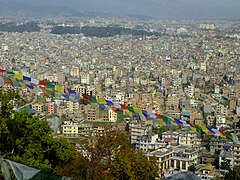Kathmandu
The ancient trade route between India and Tibet that passed through Kathmandu enabled a fusion of artistic and architectural traditions from other cultures to be amalgamated with local art and architecture. The monuments of Kathmandu City have been influenced over the centuries by Hindu and Buddhist religious practices. The architectural treasure of the Kathmandu valley has been categorized under the well-known seven groups of heritage monuments and buildings. In 2006 UNESCO declared these seven groups of monuments as a World Heritage Site (WHS). The seven monuments zones cover an area of 189 hectares (470 acres), with the buffer zone extending to 2,394 hectares (5,920 acres). The Seven Monument Zones (Mzs) inscribed originally in 1979 and with a minor modification in 2006 are Durbar squares of Hanuman Dhoka, Patan and Bhaktapur, Hindu temples of Pashupatinath and Changunarayan, the Buddhist stupas of Swayambhu and Boudhanath.
Kathmandu is in the northwestern part of the Kathmandu Valley to the north of the Bagmati River and covers an area of 50.7 km (19.6 sq mi). The average elevation is 1,400 metres (4,600 ft) above sea level. The city is bounded by several other municipalities of the Kathmandu valley: south of the Bagmati by Lalitpur Metropolitan City (Patan), with which it forms one urban area surrounded by a ring road, to the southwest by Kirtipur Municipality and to the east by Madyapur Thimi Municipality. To the north the urban area extends into several Village Development Committees. However, the urban agglomeration extends well beyond the neighbouring municipalities, e.g. to Bhaktapur, and nearly covers the entire Kathmandu Valley.
- Urban expansion in Kathmandu (Mar. 2015)
- The green, vegetated slopes that surround the Kathmandu metro area (light grey, image centre) include both forest reserves and national parks
- Cloudy highway
- New Road is the shopping district of Kathmandu.
Your notes (private)
What's on your mind? (you can type here notes just for you and they will show on your dashboard)
Information for getting there
When someday comes you'll need to get in.
Information for getting around
When someday comes you'll need to be able to get around.
Your tips and questions
Let us know your best tips about Kathmandu.




